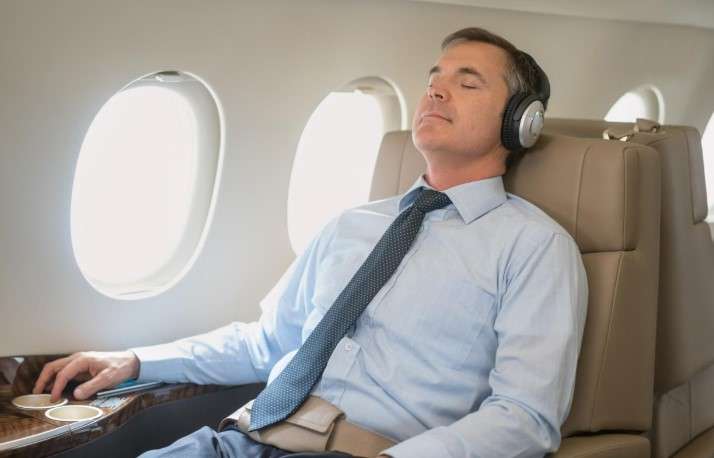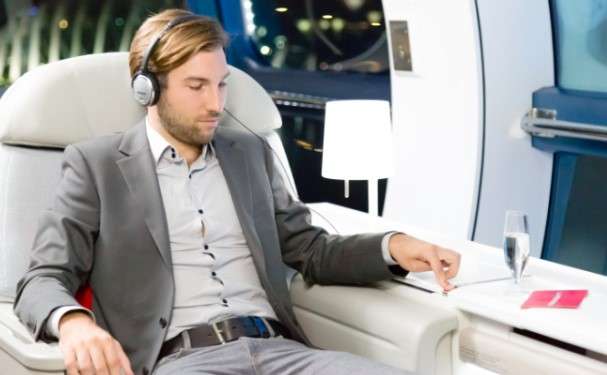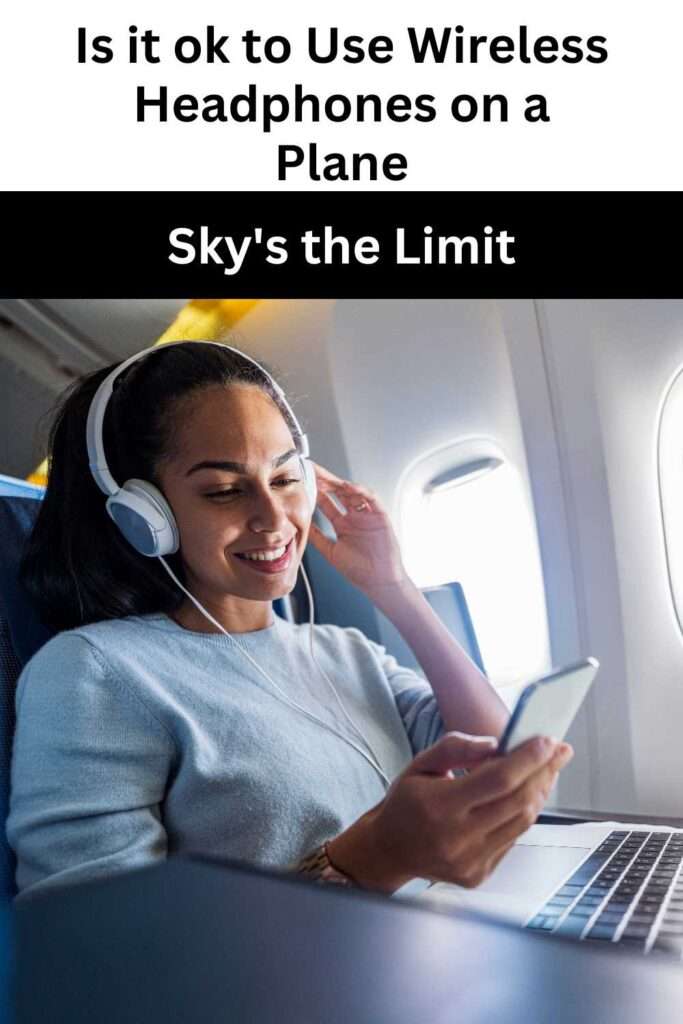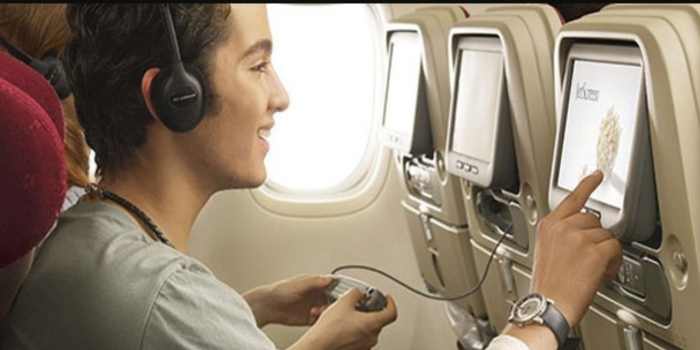In an increasingly networked and interconnected world, wireless headphones have become an everyday part of our lives. As we increasingly rely on mobile devices for anything from leisurely music listening to productivity during exercises, it’s only reasonable to contemplate carrying them on board during flights.
Wireless headphones are an appealing companion for the modern traveler due to their ease of use, improved audio quality, and compatibility with in-flight entertainment systems. However, as technology becomes more integrated into our airborne experiences, questions arise concerning the appropriateness of utilizing wireless headphones on a plane.
Exploring the Use of Wireless Headphones on a Plane
In this topic we will cover:-
- The Rules for Using Bluetooth Headphones on a Plane
- Advantages of Using Wireless Headphones on a Plane
1. The Rules for Using Bluetooth Headphones on a Plane

In a world where wireless technology rules, Bluetooth headphones have become indispensable for tourists looking for a clear audio experience.
However, in order to guarantee a peaceful and secure journey for every passenger, there are a few guidelines and things to keep in mind when utilizing these gadgets on an aircraft. Now let’s examine the rules regarding the use of Bluetooth headphones on airplanes:
Examine the policies of the airline
It’s important to educate oneself with the airline’s unique policies prior to boarding. While many airlines allow the use of Bluetooth headphones, there may be variations in their policies, and others may impose limitations during particular flight segments.
Incorporate Airplane Mode
Electronic gadgets are usually put into airplane mode once on board. Enabling airplane mode guarantees that all wireless communications, including Bluetooth signals, are deactivated, minimizing any interference with the aircraft’s systems even if Bluetooth headphones are normally permitted and operate on low power.
Follow the instructions on the seatbelt sign
Passengers are typically forced to store electronic devices during essential flight phases, such as takeoff and landing. Even if Bluetooth headphones are permitted, it’s imperative that you heed the cabin crew’s instructions and store your electronics when the seatbelt indicator illuminates.
Observe Noise Levels
Bluetooth headphones have the ability to create a private audio environment, particularly those with noise-canceling functions. Nonetheless, it’s imperative to pay attention to the volume level in order to prevent upsetting other travelers. Adjust the volume so that only you can hear it, and make responsible use of any noise-canceling functions.
Talk to your seatmates
Be upfront and honest with your seatmates about your plan to utilize Bluetooth headphones. Respect their choices, particularly if they are worried about possible disruptions or loudness. Having a conversation and identifying points of agreement makes things more comfortable for everyone.
Keep a Backup on Hand
Even though Bluetooth headphones are generally dependable, it’s a good idea to have an extra set of wired headphones on hand. This can come in handy if you experience problems with Bluetooth connectivity or if a fellow traveler asks you to use wired headphones in order to allay their worries.
Recharge your electronics
Make sure your Bluetooth headphones are completely charged before the trip to prevent any disturbances in the event that the battery dies. Since not every seat on an airline has a charging port, bringing a charged gadget ensures continuous use during the flight.
2. Advantages of Using Wireless Headphones on a Plane

Wireless headphones have become a necessary travel item in a time when technology is changing the way we see the world. The benefits of utilizing wireless headphones during plane travel go beyond simple convenience. Let’s examine the factors that have led many jet-setters to choose these stylish, cordless gadgets:
Increased Flexibility and Unrestricted Movement
Travelers who use wireless headphones are freed from the shackles of tangled cables. With their increased independence, travelers can now walk around the cabin, extend their legs, and get things from the overhead bins without being strapped into a seat.
Using Noise Cancellation to Create an Immersion in Audio
Advanced noise-canceling functions are included with a lot of wireless headphones. With the help of this technology, background noise is greatly reduced, allowing for a peaceful haven amid the drone of airplane engines. With unmatched clarity, passengers may enjoy movies, music, or podcasts, which improves the overall in-flight entertainment experience.
In-flight Entertainment System Compatibility
More and more airlines are offering in-flight entertainment systems that let customers watch a variety of films, TV series, and songs. These systems may be connected to wireless headphones with ease, providing a customized audio experience without the hassle of wired connections.
Minimal Cord Mess and Simplicity of Use
Not only does the lack of cables create a more organized personal area, but it also makes settling in during flight easier. It’s simple to pair wireless headphones with gadgets, so you don’t have to worry about tangles or short cable lengths.
Flexibility across Various Devices
Multiple device connections are frequently possible with wireless headphones. Travelers can effortlessly switch between their tablet, smartphone, and the in-flight entertainment system thanks to this versatility, which eliminates the need for frequent reconfiguration.
Conclusion
As we soar through the clouds in an era defined by wireless connectivity, the use of Bluetooth headphones on a plane has become an integral part of the modern traveler’s journey. The advantages of wire-free audio and the convenience they bring to in-flight entertainment are undeniable.
However, as with any technological convenience, there are important considerations and etiquettes to uphold for a harmonious and safe flying experience.
In conclusion, using Bluetooth headphones on a plane is not only acceptable but can significantly enhance your travel experience. The freedom of movement, noise-canceling features, and compatibility with in-flight entertainment systems make wireless headphones a valuable companion in the skies.
Frequently Asked Questions
- Are Bluetooth headphones allowed on all airlines?
- Airlines generally permit the use of Bluetooth headphones. However, specific rules may vary between carriers, so it’s essential to check the policies of the airline you are flying with.
- Do Bluetooth headphones interfere with the aircraft’s systems?
- Bluetooth technology in headphones operates on low power and is designed not to interfere with aircraft systems. However, it’s advised to switch devices to airplane mode during flight to comply with regulations and minimize potential interference.
- Can I use Bluetooth headphones during takeoff and landing?
- During critical phases of the flight, such as takeoff and landing, electronic devices, including Bluetooth headphones, may need to be stowed. Follow the instructions of the cabin crew and adhere to the illuminated seatbelt sign.
- How can I ensure my Bluetooth headphones have enough battery for the entire flight?
- Charge your Bluetooth headphones fully before the flight. Bringing a charging cable and considering a portable power bank can be beneficial for long-haul journeys.

